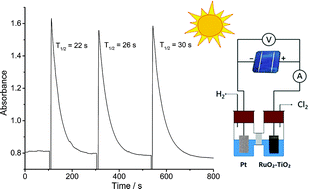Light-driven generation of chlorine and hydrogen from brine using highly selective Ru/Ti oxide redox catalysts†
Abstract
Ultrafine ruthenium–titanium oxide catalysts were directly produced using a continuous hydrothermal flow synthesis process and assessed as chloride oxidation catalysts. Selectivity towards chlorine (over oxygen) evolution was shown to generally increase with decreasing ruthenium content. The optimum catalyst was then used to make an anode for a light-driven brine-splitting demonstrator device to produce hydrogen and chlorine gases.



 Please wait while we load your content...
Please wait while we load your content...